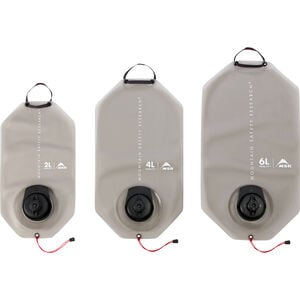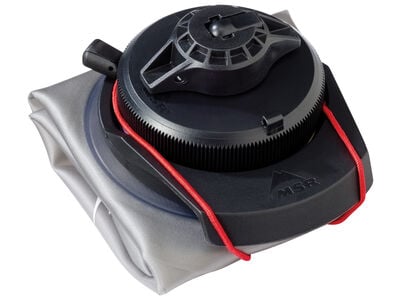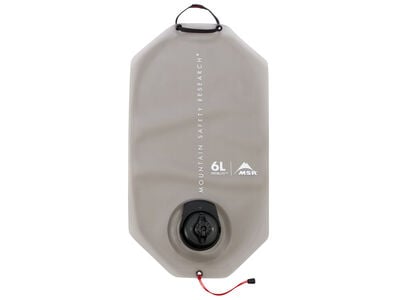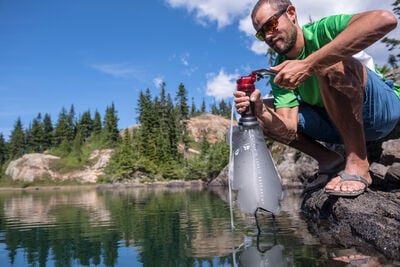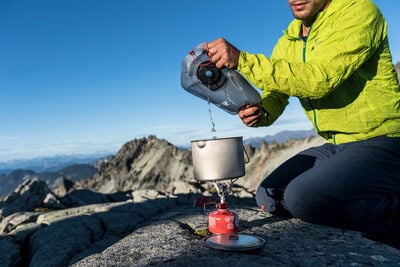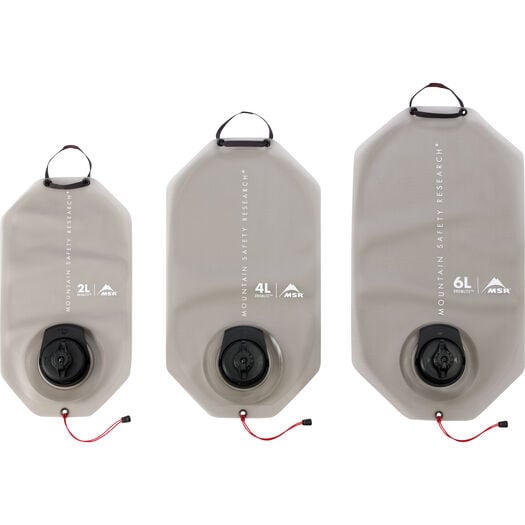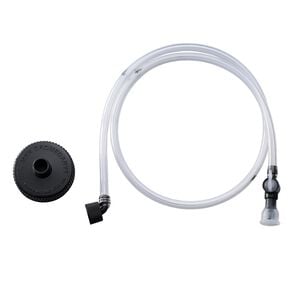Why do I need a filter or purifier?
All surface waters have the potential to be contaminated with at least one of the three types of disease-causing microorganisms:
protozoa,
bacteria, and
viruses. While it is true that you can drink directly from many water sources, it is critical to understand that each time you do, there is a chance of ingesting one of these bugs. Infection symptoms can range from an upset stomach to debilitating illness and, depending on where you are, can mean anything from a simple inconvenience to a life-threatening situation. Since microorganisms are impossible to see, taking the proper precautions with any water can help to ensure a safe trip.
Quelle est la différence entre un filtre et un purificateur ?
La principale différence réside dans le niveau de protection qu’ils assurent. D’une manière générale, un filtre à eau est conçu pour éliminer les protozoaires et les bactéries qui vivent dans l’eau, mais pas les virus. Un purificateur d’eau est conçu pour combattre les trois classes de microbes, y compris les virus.
En règle générale, les filtres constituent une méthode de traitement de l’eau suffisante, car les régions reculées en Amérique du Nord sont considérées comme présentant un faible risque de contamination par les virus. Dans les endroits très fréquentés par les humains ou lorsque les systèmes d’assainissement présentent des déficiences, le risque de présence de virus augmente. Dans ces régions, notamment dans les pays en développement, un purificateur est recommandé.
De plus, les filtres éliminent physiquement les particules et les microbes présents dans l’eau. En revanche, un « purificateur » peut utiliser diverses méthodes pour accomplir leur tâche, depuis l’élimination physique des contaminants jusqu’à la désinfection de l’eau par des traitements par rayons UV ou produits chimiques.
Pourquoi deux types de système pour le traitement de l’eau ? Les virus sont tout simplement trop petits pour que les filtres puissent les retenir. Bien plus petits que les protozoaires ou les bactéries, les virus passent à travers les matériaux filtrants utilisés dans les filtres pour la randonnée. Il fallait généralement utiliser des rayons UV, des produits chimiques ou l’ébullition pour désactiver les virus, en altérant leur ADN ou en les tuant. Aujourd’hui, les nouvelles avancées en matière de purificateurs physiques représentent une solution pratique pour éliminer rapidement et facilement les virus, sans autre traitement.
Le débit des purificateurs physiques est généralement plus lent que celui des filtres, car le matériau filtrant interne qui élimine les contaminants doit être d’un calibre suffisamment fin pour capturer de minuscules virus. Cela ralentit la vitesse à laquelle l’eau traverse ce matériau filtrant, ce qui diminue le débit général.
What is the scoop on protozoan parasites?
Protozoa are the largest of the waterborne bugs measuring in the one-micron range. Giardia and cryptosporidia are the most infamous of the group. The infective cysts and oocysts of protozoa are extremely robust and can survive for months in a water source. They thrive in domestic and wild animals as well as humans. Cryptosporidia oocysts are known for their resistance to chemical treatment. Most disinfectants are ineffective, and the few that are require long dwell times to do the job.
What is the scoop on bacteria?
Bacteria are an order of magnitude smaller than protozoa measuring in the 0.5 - 2 micron range. The most well-known bacteria are E. coli; others include Leptospira (which causes Leptospirosis), Campylobacter, Salmonella, and Shigella. Bacteria aren't as hearty, surviving in water only for weeks instead of months. However, unlike protozoa and viruses, which require a host to multiply, some bacteria can grow in water and so can be found in higher numbers than protozoa and viruses. Bacteria, like protozoa, are often carried by both animals and humans. Because of this, many water sources are contaminated with bacteria. Beware especially of sources near agricultural operations.
What is the scoop on viruses?
Viruses are the smallest type of pathogen, ranging between 0.02 - 0.3 microns. Waterborne viruses are very resilient and can survive for months. It is important to note that viruses are generally species-specific. In other words, those that infect animals do not infect humans and vice versa. Because of this, and the well-maintained sewage systems in developed countries, not as many water sources are contaminated with human viruses. However, in heavily traveled backcountry areas, viruses can be present where human waste is not disposed of properly. In developing countries with little or no sewage control, viruses are often widespread and purification in such countries should be standard procedure for all travelers.
What happens if I drink water that contains viruses, bacteria and protozoa?
First, it will usually take more than one organism to make you sick—around 10 for protozoa and viruses and 10 to 1,000,000 for bacteria depending on the species. The onset of symptoms can start anywhere from 10 hours to several weeks from the point of infection depending on the type and amount ingested, and constitution of the individual. Symptoms can range from nothing to diarrhea, abdominal cramps and pain, nausea, vomiting, muscle cramps, fever, fatigue, headache, chills, loss of appetite, and, in the case of hepatitis, dark urine and jaundice. Symptoms usually dissipate in a couple of days or weeks, again depending on the three elements above. Healthy adults will generally knock the illness without needing medical attention and without lasting effects. However, infants, young children, elderly, pregnant, and immune-compromised individuals are at higher risk of needing medical attention or having complications from an illness. Your location—a remote basecamp in Pakistan or a day hike close to home— will play a key role in the severity of your illness, should you become infected. For more information on diseases caused by specific pathogens, please visit www.cdc.gov.
What do MSR filters remove from the water?
A filter actually removes matter and microbes from the water while a "purifier" can employ a variety of methods to disinfect the water (such as UV or MIOX® or combination system like the MSR Sweetwater® purifier). A purifier must meet the EPA Guide Standard for Testing Microbiological Purifiers, which requires inactivation of all three classes of microbes: protozoa, bacteria and viruses. Filters in general claim to remove only protozoa and bacteria, making it adequate for most travel in developed countries. Some filters alone can qualify as a purifier, but since they are filtering to such a small pore size, they tend to clog quickly. Essentially the classification as a "purifier" means that the device must be capable of inactivating viruses, as well as protozoa and bacteria.
What does inactivate mean?
Inactivate means to damage a microorganism sufficiently to render it harmless.
How do I decide whether a filter or a purifier is best for me?
To decide whether you need a filter or a purifier, two important factors must be evaluated: water sources and susceptibility.
When evaluating water sources it is important to keep the following in mind: In general, protozoa and bacteria infect both animals and humans and are transmitted to water sources by animal and human waste. In contrast, waterborne viruses are species-specific and therefore transmitted to water sources by human waste alone. As a rule of thumb, remote areas with few people require (at least) filtration while popular areas with many human visitors require purification. If traveling in developing countries with poor sanitation, purification will be your safest choice.
Susceptibility is another good way to determine needs. If the treated water is to be consumed by infants or young children, elderly, or pregnant or immunocompromised individuals, then it is essential to use a purifier for the highest level of protection. Purification is also best for people who tend to get sick. If you rarely get sick and do not fit into any categories mentioned above, then filtration may be adequate depending on the water source.
What pore size or micron rating are the MSR filters?
Micron ratings aren't always the best way to gauge effectiveness. Test procedures for micron ratings vary so greatly that comparing them is misleading. In addition, micron ratings for filters do not tell you how the product will perform with actual bugs. There is an EPA Guide Standard for Testing Microbiological Purifiers, which describes how to test products to determine if they are removing or inactivating the proper number of pathogens in different types of water throughout the life of the device. When looking for a microfilter or purifier ask if the product has been tested according to the EPA Guide Standard and passed. For a microfilter, meeting the EPA Guide Standard means removing 99.9% of protozoa and removing 99.9999% of bacteria in all required water types. To be classified as a purifier, the device must meet the EPA Guide Standard for the removal of protozoa and bacteria as well as virus which must be inactivated to 99.99% in all required water types. All of the MSR filters and purifiers have passed the levels of inactivation required by the EPA Guide Standard with flying colors.
Will my filter or purifier protect me from bioterrorism?
As a result of the September 11 attack and the following concerns about bioterrorism, we have received a number of inquiries regarding our microfilters' ability to protect against such threats. MSR microfilters will protect you from harmful microorganisms that are 0.2 microns or larger. The anthrax bacteria, for example, measures about 8 microns and would be removed by all MSR filters. Additionally, if a water reservoir were contaminated with a biological agent, it is unlikely that enough organisms could be added or would survive the treatment process of the water plant to provide an infectious dose at the tap. Our water supply is more likely to be compromised or cut off completely as a result of a natural disaster, such as an earthquake or hurricane, or by a general state of disorder following any kind of attack or natural disaster. By including a good water treatment device (and knowing how to use it) in your emergency kit, you will be prepared for most situations.
Do MSR filters and purifiers remove chemical contaminants from the water?
MSR filters and purifiers provide microbiologically safe drinking water. Several MSR filters feature a carbon component that reduces some chemical contaminates such as herbicides, pesticides, and volatile organic compounds (VOCs). However, MSR filters or purifiers will not protect you from high chemical concentrations or heavy metal contamination. Do your best to avoid water sources such as mining tailing ponds or those near agricultural operations.
How will tannins (tea-colored water) affect my filter or purifier?
MSR filters will remove some tannins from the water you are filtering. Like other contaminants, they will clog your filter over time, requiring you to clean the cartridge. Tannins will react with disinfectants and can make treated water taste unpleasant. If possible, look for a clear water source to prolong the life of your filter and improve the taste of purified water.
What is the warranty on MSR filters and purifiers?
MSR filters and purifiers come with a limited warranty. Contact our Warranty and Repairs Department at 1-800-531-9531 if there are any problems with your filter or purifier and they will be happy to help with solutions.
If I own a TrailShot filter, can I purchase the dirty water bag and adapter to create my own Trail Base gravity system?
Not at this time. Your TrailShot filter is not compatible with the gravity components of the Trail Base Water Filter Kit. Therefore, we don’t sell those gravity components separately. While the TrailShot filter and the small filter in the Trail Base Kit look similar, they are indeed different—particularly their spouts and prefilters. Therefore, the TrailShot will not integrate with the Trail Base’s gravity components. We are considering making design adjustments that will allow for integration in the future.
Une valve et un tuyau de purge, qu’est-ce que c’est ? Pourquoi le purificateur par gravité Guardian en est-il équipé ?
Le purificateur par gravité Guardian est équipé d’un tuyau et d’une valve de purge qui permettent de nettoyer directement le système sans avoir à le rincer par rétrolavage. Ouvrez la valve de purge pour évacuer la saleté et l’air jusqu’à ce que la couleur de l’eau corresponde à celle de l’eau à traiter et qu’il n’y ait plus de bulles. Cela permet d’améliorer le débit, car l’air emprisonné dans la cartouche du purificateur peut réduire le débit de l’eau. Tenez la cartouche à l’horizontale ou tapotez doucement la cartouche pendant que l’eau s’écoule pour aider à bien évacuer tout l’air.
Attention : de l’eau contaminée très concentrée sort du purificateur et est rejetée par la valve de purge. Aucune goutte sortant du tuyau de purge ne doit toucher l’eau purifiée.
Pourquoi le débit de mon filtre ou purificateur par gravité est-il si lent ?
Les filtres et purificateurs par gravité utilisent la force de la gravité pour forcer l’eau à travers le matériau filtrant du filtre ou purificateur, et remplir le récipient destinataire pour l’eau potable. Plus le réservoir d’eau sale est en hauteur au-dessus de la sortie pour l’eau filtrée, meilleur sera le débit.
Pour augmenter le débit, essayez d’abord de suspendre le réservoir aussi haut que possible au-dessus de la sortie pour l’eau filtrée. Ensuite, purgez l’air du système en suivant les instructions fournies avec le filtre ou le purificateur (disponibles également dans la section Vidéos).
Si vous avez beaucoup utilisé le filtre ou purificateur, il est peut-être temps de remplacer l’élément filtrant/purificateur.
